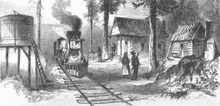
Moss Neck is a community in Robeson County, North Carolina, United States.
History
Moss Neck is located in west-central Robeson County. [1] The name was coined by Native Americans to refer to a stream in the area, and it was later applied to the community after it was settled. [2] It began as a center for turpentine distillation, though as local pine forests were depleted the industry moved south. The community remained due to the presence of a post office and a cooperage. [3] In January 1861, the Wilmington, Charlotte and Rutherford Railroad built a line through the village. [4] A railway station was established, leading to a revitalization of the local community, and it became a center of Lumbee activity. [5] It was frequented by members of the Lowry Gang during the Lowry War. [6] In 1892, the Wilmington and Weldon Railroad proposed building a north-south line through Moss Neck, but at the opposition of a prominent citizen the line was moved a few miles west to Campbell's Mill, which shortly thereafter became Pembroke. [7] By 1909, in addition to the railway station, the community hosted several homes, two turpentine distilleries, a water mill, a sawmill, a hotel, a post office, a school, and a Methodist church. Over the following decades, the community declined as the turpentine industry moved southward and naval stores were supplanted by steel in shipbuilding. [8] The station at Moss Neck was eventually closed, [9] and other business migrated to Pembroke. In the 1920s the Methodist church was disassembled and rebuilt in Pembroke. By 1949, the town was largely deserted. [8]
References
- ^ Powell 1976, p. 336.
- ^ "Origins of Names of Robeson Towns". The Robesonian. February 26, 1951. p. 13.
- ^ Dial & Eliades 1996, pp. 80, 142.
- ^ Watson 2016, p. 225.
- ^ Dial & Eliades 1996, pp. 62, 142.
- ^ "The Life and Times of Henry Berry Lowry". The Carolina Indian Voice. Vol. 5, no. 7. February 17, 1977. p. 6.
- ^ Dial & Eliades 1996, p. 142.
- ^ a b Seawell, Helen (February 23, 1949). "Only Sign Remains At Moss Neck, One-Time Thriving Trade Center". The Robesonian. p. 4.
- ^ Blu 2001, p. 10.
Bibliography
- Blu, Karen I. (2001). The Lumbee Problem: The Making of an American Indian People (reprint ed.). Lincoln: University of Nebraska Press. ISBN 978-0-8032-6197-6.
- Dial, Adolph L.; Eliades, David K. (1996). The Only Land I Know: A History of the Lumbee Indians (1st Syracuse University Press ed.). Syracuse: Syracuse University Press. ISBN 978-0-8156-0360-3.
- Powell, William S. (1976). The North Carolina Gazetteer: A Dictionary of Tar Heel Places. Chapel Hill: The University of North Carolina Press. ISBN 9780807812471.
- Watson, Alan D. (2016). Wilmington, North Carolina, to 1861. McFarland. ISBN 9780786482146.

Moss Neck is a community in Robeson County, North Carolina, United States.
History
Moss Neck is located in west-central Robeson County. [1] The name was coined by Native Americans to refer to a stream in the area, and it was later applied to the community after it was settled. [2] It began as a center for turpentine distillation, though as local pine forests were depleted the industry moved south. The community remained due to the presence of a post office and a cooperage. [3] In January 1861, the Wilmington, Charlotte and Rutherford Railroad built a line through the village. [4] A railway station was established, leading to a revitalization of the local community, and it became a center of Lumbee activity. [5] It was frequented by members of the Lowry Gang during the Lowry War. [6] In 1892, the Wilmington and Weldon Railroad proposed building a north-south line through Moss Neck, but at the opposition of a prominent citizen the line was moved a few miles west to Campbell's Mill, which shortly thereafter became Pembroke. [7] By 1909, in addition to the railway station, the community hosted several homes, two turpentine distilleries, a water mill, a sawmill, a hotel, a post office, a school, and a Methodist church. Over the following decades, the community declined as the turpentine industry moved southward and naval stores were supplanted by steel in shipbuilding. [8] The station at Moss Neck was eventually closed, [9] and other business migrated to Pembroke. In the 1920s the Methodist church was disassembled and rebuilt in Pembroke. By 1949, the town was largely deserted. [8]
References
- ^ Powell 1976, p. 336.
- ^ "Origins of Names of Robeson Towns". The Robesonian. February 26, 1951. p. 13.
- ^ Dial & Eliades 1996, pp. 80, 142.
- ^ Watson 2016, p. 225.
- ^ Dial & Eliades 1996, pp. 62, 142.
- ^ "The Life and Times of Henry Berry Lowry". The Carolina Indian Voice. Vol. 5, no. 7. February 17, 1977. p. 6.
- ^ Dial & Eliades 1996, p. 142.
- ^ a b Seawell, Helen (February 23, 1949). "Only Sign Remains At Moss Neck, One-Time Thriving Trade Center". The Robesonian. p. 4.
- ^ Blu 2001, p. 10.
Bibliography
- Blu, Karen I. (2001). The Lumbee Problem: The Making of an American Indian People (reprint ed.). Lincoln: University of Nebraska Press. ISBN 978-0-8032-6197-6.
- Dial, Adolph L.; Eliades, David K. (1996). The Only Land I Know: A History of the Lumbee Indians (1st Syracuse University Press ed.). Syracuse: Syracuse University Press. ISBN 978-0-8156-0360-3.
- Powell, William S. (1976). The North Carolina Gazetteer: A Dictionary of Tar Heel Places. Chapel Hill: The University of North Carolina Press. ISBN 9780807812471.
- Watson, Alan D. (2016). Wilmington, North Carolina, to 1861. McFarland. ISBN 9780786482146.
